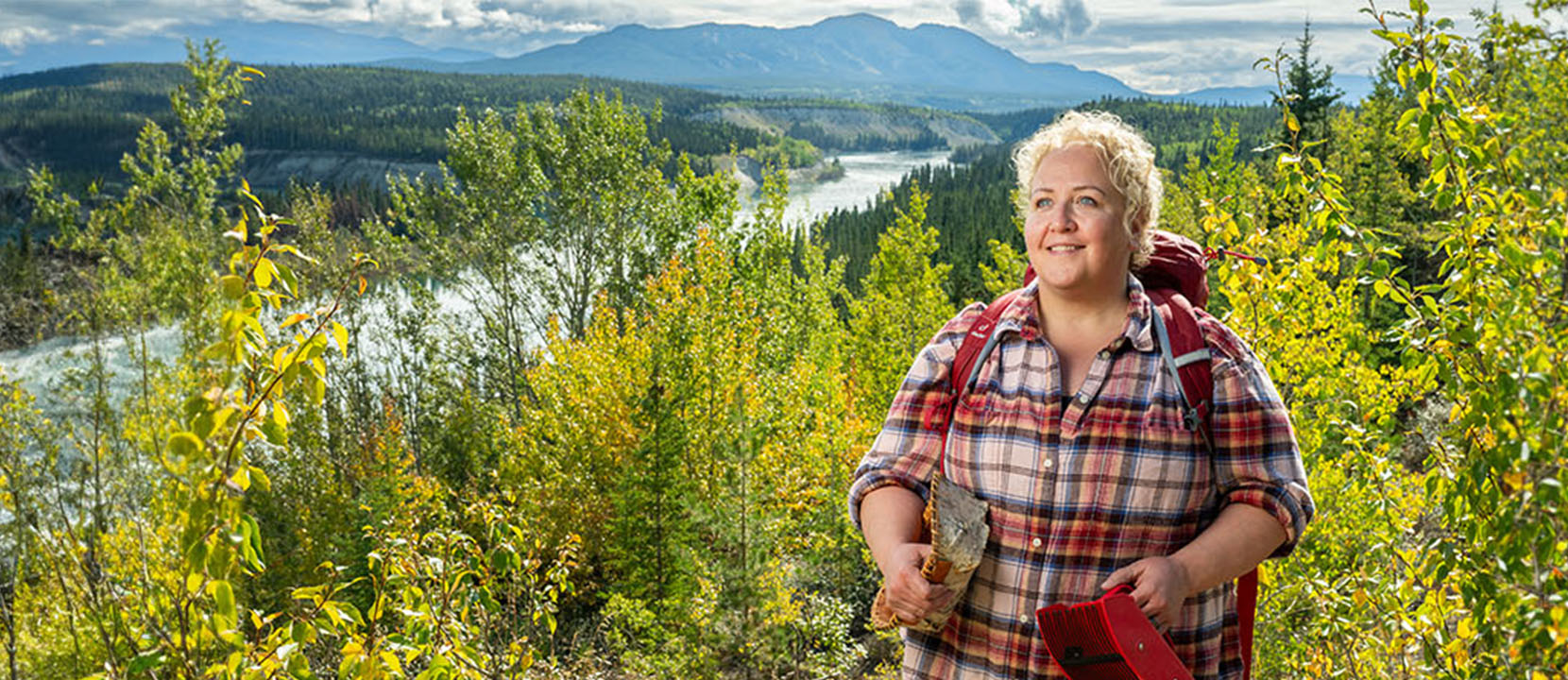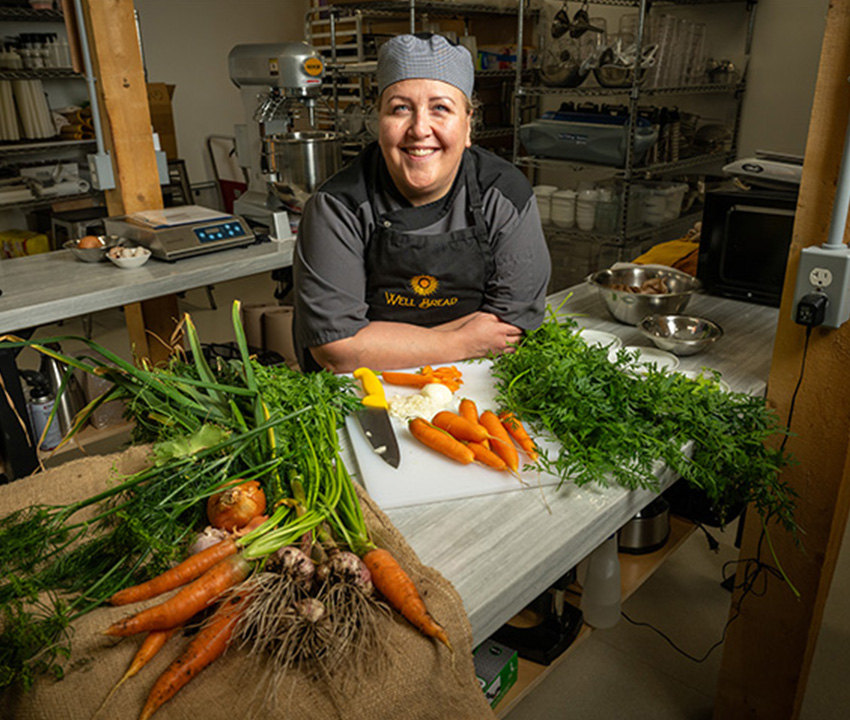Chef Cat McInroy (BPA '16) is one of a handful of Red Seal-certified chefs and bakers in northern Canada, but she won't be found cooking in restaurant kitchens. Instead, you'll find her teaching cooking classes in students’ homes or at the Well Bread Culinary Centre — her cooking school located in Whitehorse — or providing culinary consulting to various eateries. On her days off, you'll find her testing recipes or baking bread from her 125-year-old sourdough starter. It's a full schedule for someone who is semi-retired, but she wouldn't have it any other way.
The youngest of seven kids born to first-generation Canadians in the Yukon, McInroy learned her way around the kitchen at a young age with her mother. Being up north, where food can sometimes be scarce, she was immersed in the practices of sustenance living and making the most of the ingredients available. She combines this lifelong expertise with the soothing mother-hen energy she cultivated during her 20-year career as an RCMP first responder to bring out the best in home cooks of all ages. Whether her students are nine or 99 years old, McInroy can relate to her students, evaluate their skill levels, and boost their knowledge and confidence in just one three-hour class.
McInroy sat down with LINK writer Giselle Wedemire to discuss how she connects with her community through her passion for food and education.

Chef Cat McInroy foraging near the Yukon River, using a comb-style berry picker. The birch bark collection basket is for dry ingredients like mushrooms.
Were you always interested in cooking?
From a very early age, my mum immersed me fully in food and its preparation, including learning how to fish, farm and hunt. We weren't raised on anything processed, and we made all our food from scratch. In the north, you don't just go to the grocery store to get what you need — you plan ahead. You waste nothing and make do with what you have. That is where my passion for cooking formed.
Food is amazing because it can help us communicate without words, even with a language barrier. You can set a plate in front of someone and watch them appreciate and savour that meal. Food unites everyone, and it also connects us to our cultures and our pasts.
Speaking of the past, what can you tell me about being the steward of a 125-year-old sourdough starter?
I call the starter 'Klondike' because it dates back to the Klondike Gold Rush. It's a legacy piece of Yukon history that sustained life here 125 years ago, and as a Yukoner, I felt it needed to be protected. After studying at SAIT, I contacted Ione Christensen (a legendary senator born and raised by gold miners who brought Klondike here in 1898) and asked if I could become its guardian. She agreed, and it's been in my care for the last six years.
Every time you eat bread made from Klondike, you're biting into a piece of history. I keep some of it dehydrated and locked away in a fire-proof safe to preserve its integrity, and I also keep some of it in my fridge in a liquid, semi-dormant state for regular personal use and sharing. This is the Yukon's sourdough, not mine, so if you want some of it, you can have it. I give it away for free locally and on my website. At this point, some of Klondike has been sent to every continent, including Antarctica.
At the Well Bread Culinary Centre, you encourage your students to partake in urban foraging in the garden behind your facility. Why is that?
Most people don’t know where their food comes from, and we have become disconnected from the source of our food. I figure if I can give students a hands-on, real-time experience to harvest their ingredients and teach them how to make a carrot dish from our harvest plus a tangy pesto out of carrot tops, our cooking lesson becomes an educational experience where they can transform what they thought was going to become compost into an active part of their meal.
I’ve learned all about traditional and responsible foraging from my parents (who were taught by their Indigenous friends) and from local foragers — some of whom are Indigenous elders. A basic rule of thumb is to take no more than 10 per cent of the food you find. That means you don’t pull the berry bush out of the ground when harvesting berries, and you cut the mushroom at the base instead of pulling it from the earth. This ensures the plants can regenerate the following year.
What's the best part of your job?
I love seeing how much my teaching has impacted people — especially kids. Whether it's my kids teaching their friends how to make a gremolata for their steak or an eight-year-old student excited to show his family the dinner he made in class, I feel so proud. Because it's not me making that meal — it's them making it based on the knowledge I shared with them. And that's so powerful. If you want to change someone's life, teach them how to care for themselves.
What sets you apart as a chef-instructor?
I make cooking enjoyable, but I also show my students what to do with their meals if they make a mistake. I'm all about no waste — no food is going in the garbage with me because that's how I was raised. If you mess up, we will make it work and turn it into something new. Too often, people view their time in the kitchen as a punishment and their failures as a sign that they should give up. I don't see failures that way — I see them as learning opportunities.
What is the biggest lesson students can learn from you?
In the kitchen, the food is secondary. What's really going on is that students are learning about themselves. They're gaining confidence and taking care of themselves, and by learning to do everything by hand like our ancestors did, they're connecting with the past. There are so many lessons in the kitchen, and few have anything to do with food.

Oki, Âba wathtech, Danit'ada, Tawnshi, Hello.
SAIT is located on the traditional territories of the Niitsitapi (Blackfoot) and the people of Treaty 7 which includes the Siksika, the Piikani, the Kainai, the Tsuut’ina and the Îyârhe Nakoda of Bearspaw, Chiniki and Goodstoney.
We are situated in an area the Blackfoot tribes traditionally called Moh’kinsstis, where the Bow River meets the Elbow River. We now call it the city of Calgary, which is also home to the Métis Nation of Alberta.
